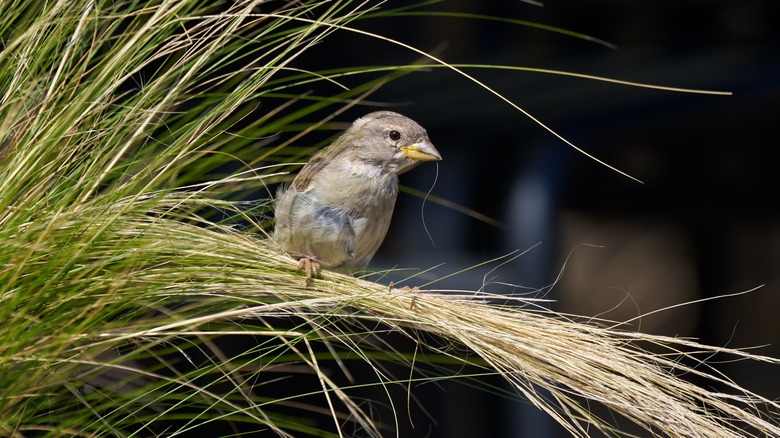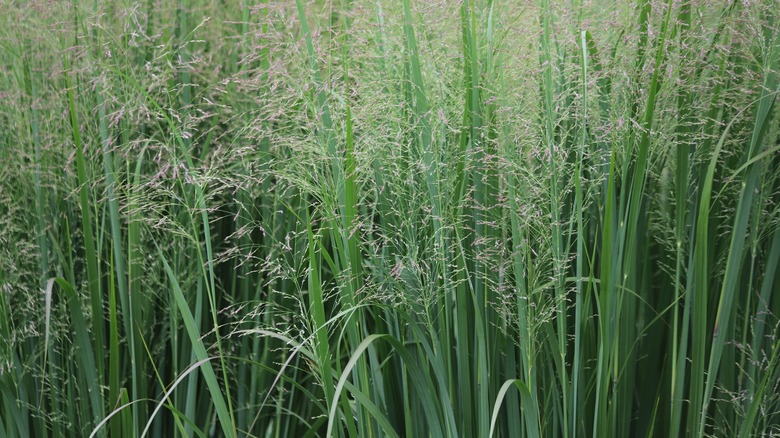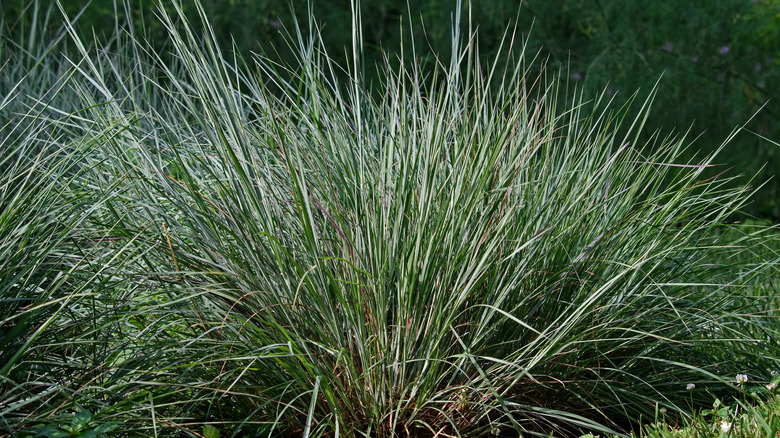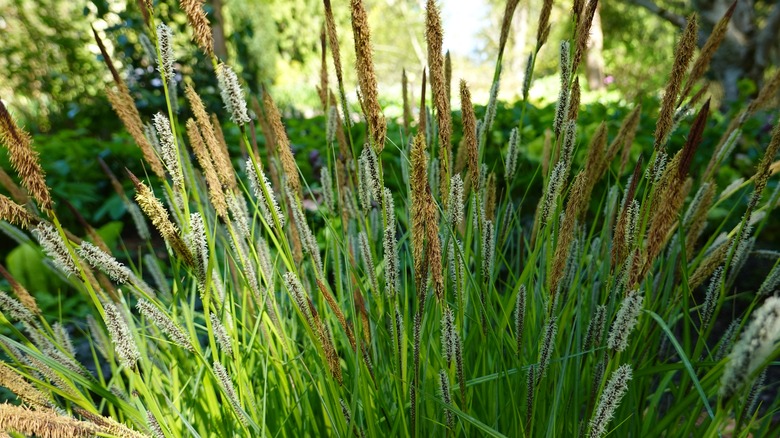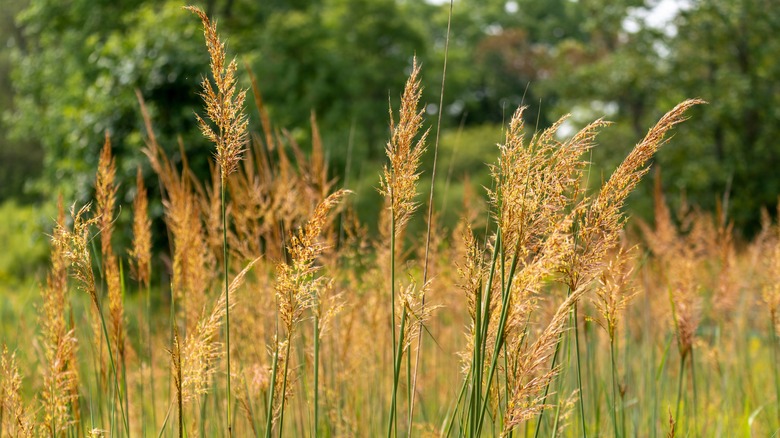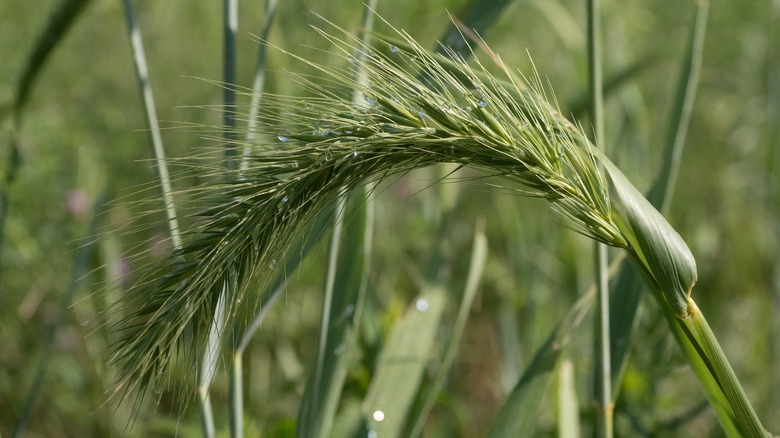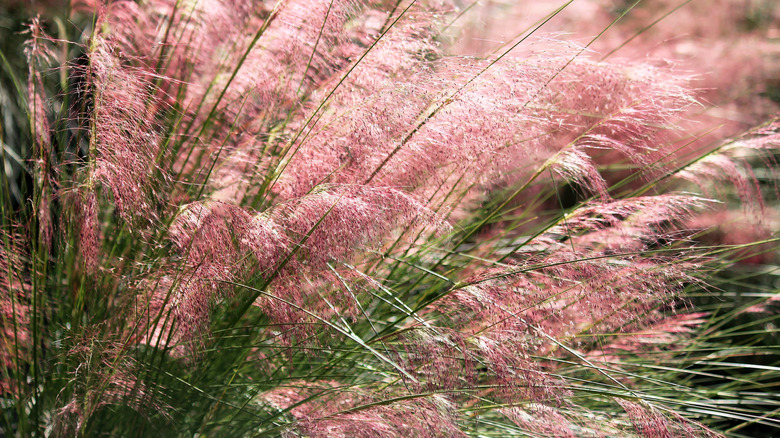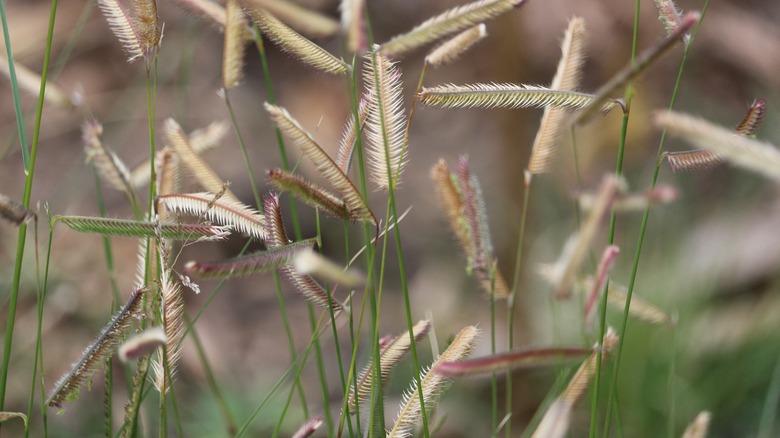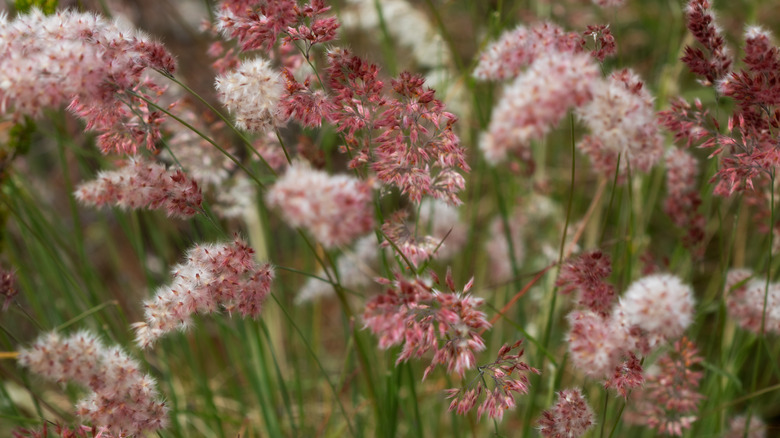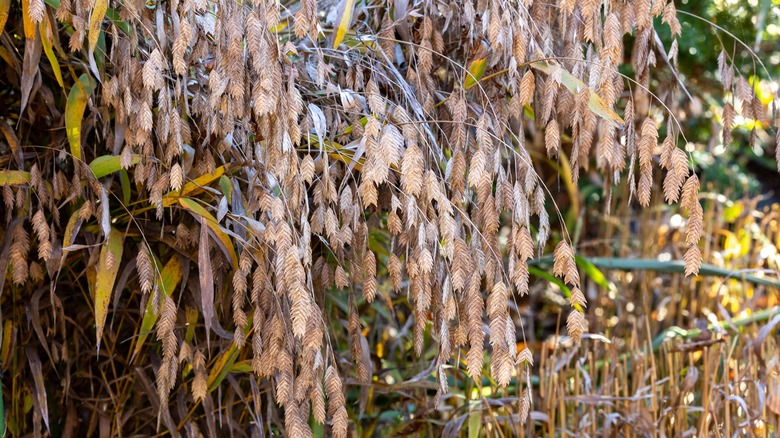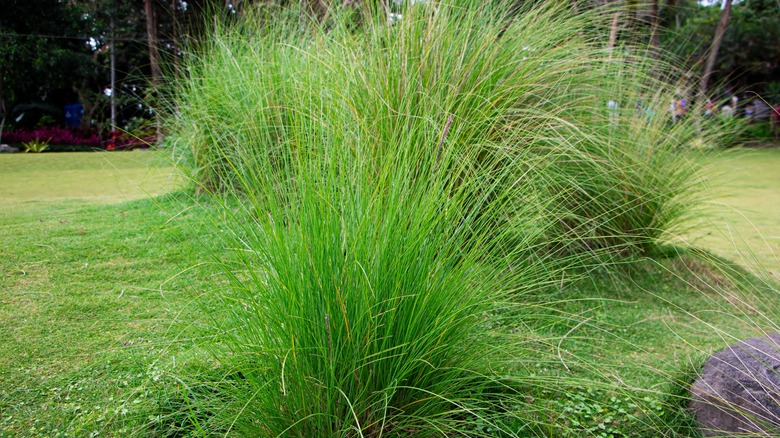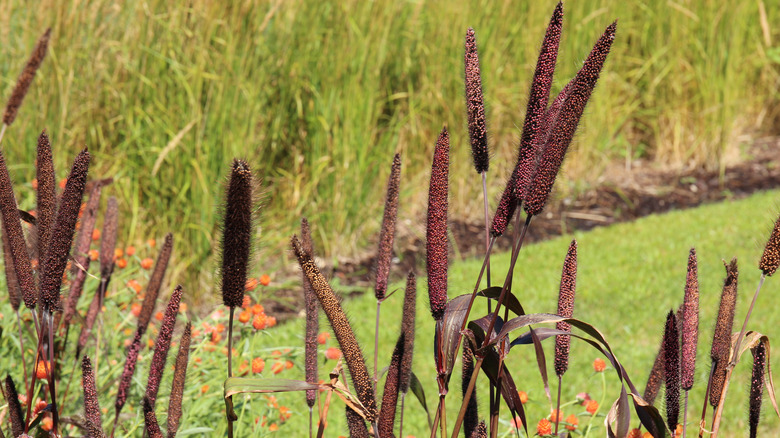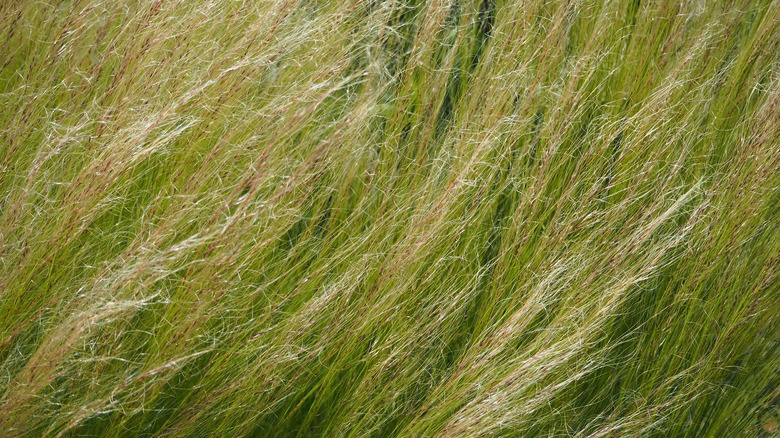Unique Types Of Grass To Plant In Your Yard That Birds Can't Resist
When you think of attracting birds to your garden, you likely imagine a yard filled with tall trees, cozy birdhouses, and a few seed-filled feeders. Surprisingly, there are several advantages of having ornamental grass in your landscaping, including its appeal to birds. Our feathered friends have simple needs, primarily food and shelter. Many decorative grasses have seeds, which are the perfect choice for birds looking for their next meal. Some of these plants are also host plants for pollinators like moths, whose larvae are a favorite of several bird species in need of extra protein.
Not only are the pretty grasses a one-stop-shop for birds to refuel, but they may also take advantage of the materials to build their nests. Birds use various natural sources for nesting, including twigs, leaves, feathers, and strong, flexible grasses. Some species, including robins and song sparrows, line their youngs' bedding with grass as the main structure. Grasses with soft, fluffy seed heads are popular among hummingbirds, who work hard to create insulated homes for their delicate eggs. The dense foliage is also a top choice for ground-nesting birds, while also providing plenty of cover, keeping them hidden from predators and protected from the elements. Make your yard irresistible by adding varying types of grasses to create a diverse habitat that attracts a wider array of bird species. Don't be surprised if your showy grass attracts other types of wildlife, like other small animals and butterflies, too.
Attract over 30 bird species with switch grass
Growing as tall as 3 to 6 feet, switch grass (Panicum virgatum) is a beautiful choice to add texture, color, and movement to your garden. In spring, it brightens up your yard with lush green foliage. As the weather warms up, the switchgrass produces small, reddish-purple-tipped flower seeds that over 30 bird species, including cardinals, juncos, and sparrows, can't resist snacking on. In autumn, the colors transform to shades of yellow and golden brown, enhancing your fall landscape. The colors continue to lighten over winter, but don't let the fading colors fool you. Unless under heavy snow, this grass remains upright, providing a protective cover for birds and other small animals.
This native grass spreads through underground rhizomes, so you'll want to make sure you have space for it. Hardy in USDA zones 5 through 9, this clump-forming plant is low-maintenance and easy to grow, tolerating both wet and dry soils, as long as they're well-draining. You'll want to choose a sunny spot in your yard for planting, as shady locations can make the blades slump. Once established, the only upkeep required is cutting back old foliage in late winter or early spring to encourage new growth. Although this easygoing grass is a wildlife haven for several species, deer aren't as fond of it. Switch grass will add the perfect touch of charm to nearly any garden style, looking stunning in borders or as an attractive backdrop for flowers.
Little bluestem is a magnet to cardinals and other songbirds
Although little bluestem (Schizachyrium scoparium) gets its name from its bluish-tinged stems that emerge in spring, the brilliant display of fall foliage is the main attraction. In autumn, the blades of grass turn to an impressive reddish-tan shade with fluffy silvery-white seed heads. Several songbirds, like cardinals, finches, buntings, song sparrows, and towhees, are particularly attracted to their seeds. So, expect to see an array of birds stopping by your yard for a treat from October to March. Little bluestem is also prime real estate for many ground-nesting species, like common yellowthroats. Because this grass is a larval host plant for nine species of skipper butterflies, birds may also stop by to snag a caterpillar.
Drought-tolerant and deep-rooted, little bluestem provides nearly as many benefits to gardens as it does to local wildlife. It doesn't require much to thrive aside from full sun conditions to achieve the most vibrant shades. This grass happily lives in poor, dry soils, making it one of the best native plants to grow if you live in the Mountain West region, where you may not see a lot of rainfall. However, its extensive root system makes this tough grass a standout pick for areas that are prone to erosion. Hardy in USDA zones 3 through 9, little bluestem does well in nearly all climates. Grow as standalone grass in containers or in groups along borders, in beds, or in a rock garden.
Provide ideal nesting material with tussock sedge
Tussock sedge (Carex stricta) is a plant that forms dense, clump-like structures known as tussocks, made from its leaves dying off at the base. This mound of old grass provides coverage for wetland birds, as well as amphibians like frogs, toads, and salamanders. In spring, this bluish-green plant produces small flowers clustered in spikes at the top of slender stems. The blooms give way to tiny, rich brown seed heads, which serve as food for an array of birds like cardinals, juncos, mallards, wood ducks, and wild turkeys. Some birds use the leaves and stems as nest-building materials, while species like ducks, herons, sparrows, and geese enjoy perching on the plants. Also a host plant for several insects, including moths and butterflies, tussock sedge helps support biodiversity in your garden.
This native, water-loving species thrives in moist, acidic, or neutral soils, and can even live in shallow water. Tolerating seasonal flooding, tussock sedges are perfectly suited for rain gardens and can beautifully add texture to the edges of streams or ponds in your yard. Grow this plant in a site that receives full sun to partial shade, and it'll flourish with very little maintenance. Because it grows through underground rhizomes, its spreading nature makes it ideal as a groundcover. However, if you don't want new plants popping up, you can manage tussock sedge by cutting it back in early spring or with controlled burns.
Offer winter nutrition by planting Indian grass
Known for its tall, showy foliage reaching up to 7 feet in height, Indian grass (Sorghastrum nutans) is a stunning ornamental grass that's beneficial for several forms of wildlife. In the summer, it features upright clumps of bluish-green leaves before turning to a yellowish-golden color in the fall. Atop the stems are feathery seedheads, which attract an array of songbirds who enjoy its seeds throughout winter. Its impressive size makes it the perfect hideaway for small animals, including birds, with some species building nests under the grass. Additionally, many types of insects feed on this plant, giving birds another source of nutrition.
Tolerating most soil conditions and being drought-tolerant, Indian grass can thrive in nearly any garden in USDA hardiness zones 4 through 9. Deer tend to stay clear of this showy perennial grass and it has virtually no issues with pests or disease. Because it's so low-maintenance, this is a native ornamental grass you should consider for your yard if you want to add more texture without a lot of upkeep. Choose a spot with well-draining soil and at least eight hours of sunlight, and this grass will cheerfully grow. All you'll need to worry about is removing the dead stems and foliage in the spring, and your Indian grass will do the rest.
Canada wild rye makes great coverage for birds
Often used for erosion control, Canada wild rye (Elymus canadensis) begins its growth with fresh, green shoots emerging from its base. By summer, its flowering stems start to appear, producing wheat-like seed heads. The seed heads mature in fall, transforming into a golden-brown color, and the blueish-green foliage fades to yellow. Aside from some seeds-granivorous birds, most species aren't as fond of these seeds as other grasses. Don't be discouraged, however — you'll likely get feathered friend visitors from those who rely on this plant for cover and nesting materials. Additionally, Zabulon and Woodland skippers munch on Canada wild rye caterpillars, so birds aren't completely out of luck finding food in this grass.
Reaching heights of 2 to 5 feet tall, this grass isn't picky about most of its living conditions. While it does its best when given at least eight hours of sunlight, it can thrive in most soil types, including clay or sand. Canada wild rye is another top choice for slopes or other areas in your yard needing erosion control. This cool-season native perennial is hardy in USDA zones 3 to 8 and will provide your garden with visual interest all year long.
Songbirds can't resist the seeds of Gulf Muhly
Celebrated for its graceful waves of feathery pink plumes, Gulf Muhly (Muhlenbergia capillaris) is truly a sight to behold. While the foliage is deep green in spring and early summer, the vibrant pink, cotton candy-like flowers begin to bloom by the end of fall, typically lasting 4 to 8 weeks. As temperatures cool, the dazzling color fades to a light tan, though it's still an aesthetically appealing addition. Finches, sparrows, and other songbirds relish the seeds, and several other species use the lush foliage for cover or nesting.
There isn't much Gulf Muhly can't handle, so almost any gardener can add attractive color to their landscaping with this low-maintenance stunner. Tolerating heat, humidity, salt, drought, and poor soils, this showy grass is hardy in USDA zones 6 through 11. All it asks to thrive is full sun to part shade conditions and well-draining soil. Add a splash of color by using it as a border plant, or incorporate it into different landscape types like rock or coastal gardens. Once established, this native clump-forming plant will grow to be about 3 feet tall and wide.
Ground nesting birds will love blue grama in your garden
If you're looking for a more compact and low-growing ornamental grass, look no further than blue grama (Bouteloua gracilis). Reaching only 2 feet in height and width, this native perennial features bluish-gray foliage earlier in the year before the colors transition to a golden shade with reddish or orangish hues. Its distinctive seed heads sit horizontally on top of the stems, resembling small brushes. In arid regions, you may see scaled quail stop to munch on the seeds, and some seed-eating songbirds also enjoy them. Ground-nesting birds seek cover under blue grama, and several skipper caterpillars make the foliage their home.
Native to the southern and western United States and Mexico, this species thrives in dry conditions. Once established, it's incredibly dry soil and drought-tolerant, so you'll rarely need to supplement with water. Blue grama is hardy in USDA zones 3 to 10 and likes to have plenty of sunlight to flourish. Aesthetically, you can plant this grass nearly anywhere in your garden. Whether in containers, a bed, as a border, or as a ground cover, blue grama will add plenty of visual interest to your landscape.
The fluffy seeds of bristle-leaved red-top grass are a top choice for nesting material
Aptly named, bristle-leaved red-top grass (Melinis nerviglumis), sometimes commonly referred to as ruby grass, is a bluish-green grass with fluffy ruby-red flower heads. Silky white hairs cover the flower panicles, making the plant look shimmery in the sunlight. Wind spreads the tiny black seeds with the help of the feathery tufts. While the seeds aren't palatable for birds, the soft seed heads make a cozy material for building their nests.
Hardy in USDA zones 8-10, this ornamental grass is often grown as an annual in most regions and may need to be overwintered indoors. This plant thrives when in full sun and consistently moist, well-draining soil. Ruby grass can be grown in containers or beds, or used as a border plant. It also makes a stunning addition to cut arrangements. However, it's important to note that this African native can be considered invasive in some areas and may reseed in the garden.
Entice birds with the seeds of inland sea oats
Characterized by its flat, arched-over seed heads in late summer, inland sea oats (Chasmanthium latifolium) provide a buffet for local birds. In autumn, its bluish-green foliage fades to a yellowish-gold, and the seed heads become a copper shade. Not only does this add to the fall atmosphere, but the seeds will attract birds like sparrows, juncos, towhees, and mourning doves. As a larval host to some butterfly species, other birds may swoop down and grab a caterpillar for their young. The dense foliage also shelters migrating birds and other small animals.
Unlike many other ornamental grasses, inland sea oats are shade-tolerant and can thrive in a spot in your garden that doesn't receive as much sun. This low-maintenance grass can tolerate poor soils, though it grows best in fertile soils. Although several types of wildlife will be drawn to this plant, deer tend to stay away from it. Additionally, it doesn't have issues with disease or pests and looks beautiful in nearly any garden style.
Birds will appreciate the food and cover of prairie dropseed
Prairie dropseed (Sporobolus heterolepis) is a versatile plant that fits several garden styles and provides visual interest throughout each season. As spring kicks off, this delicate ornamental grass forms round, bright-green, bushy clumps reaching up to 3 feet tall. In late summer to mid-fall, colors begin to fade to golden yellows and oranges, and bursts of tiny coriander-scented flowers appear. They're soon followed by small, round seeds that fall to the ground at maturity, and juncos, sparrows, and other birds will flock to nibble on them. The tufts of grass also make a good cover for birds looking for protection in cooler months.
Although the prairie dropseed does indeed have dropping seeds, they likely won't self-sow in your yard. Although this plant prefers living in dry, rocky soils, it grows well in most soil types, so long as they're well-draining. Plant this grass in an area with full sun for optimal growth, and once established, you'll rarely need to water it. The slender foliage makes a stunning backdrop against bolder plants, such as purple coneflower (Echinacea purpurea), though it looks beautiful whether or not it's in mixed plantings.
Goldfinches and sparrows relish munching on purple millet seeds
An All-America Selections Gold Medal Winner, this truly ornamental grass looks like it's straight out of a fairytale. Purple millet (Pennisetum glaucum), also commonly known as purple majesty, is adorned with thick blades of dark green leaves that turn into a rich purple color when exposed to the warm summer sun. Not only is the foliage eye-catching, but the long, bottle brush-looking flower spikes that emerge are also an attractive dark purple. Many birdseed mixes contain purple millet, so it's no surprise it's a favorite of species like goldfinches and sparrows.
This fast-growing annual is hardy in USDA zones 2 through 11 and will thrive in a sunny area in your garden. Choose soils that are moderately fertile and well-draining for purple millet to perform its best. Once established, this plant is drought-tolerant and will only need occasional supplemental watering. Despite the vast amount of seeds, self-seeding isn't a concern as they won't be able to grow once frost hits. Use purple millet as an accent plant where the dark foliage and flowers can provide plenty of contrast against neighboring companion species. Growing up to 5 feet tall, it also works well in borders or in containers.
Mexican feathergrass seeds are a favorite among several songbirds
Mexican feathergrass (Nassella tenuissma) may be the perfect ornamental grass for your yard, with its delicate and flowy blades. This award-winning grass is densely made up of fine green leaves that gently move with the wind. Adding more charm, the fluffy, satiny seed heads emerge in summer. Several songbirds are fans of their seeds, so be sure to keep an eye out for feathered friends in search of a nutritious meal. Birds also use parts of this plant as nesting material, so consider planting an evergreen tree nearby to provide them with a safe and cozy habitat.
Although native, it's important to note that Nassella tenuissma reseeds readily and is considered invasive in some regions, like California. This grass thrives in full sun, though it can tolerate partial shade. Hardy in USDA zones 7 to 11, it isn't picky about soil type, whether loamy, sandy, or even clay, and can grow in a range of pH levels. However, it prefers moderately fertile and well-draining blends. Mexican feathergrass is drought-tolerant once established, making it perfect for dry gardens.
